Wood furniture adds warmth and character to any home, but it requires proper care to maintain its beauty and longevity. This comprehensive guide will walk you through expert techniques for cleaning, repairing, and preserving your cherished wood furniture, ensuring it remains a stunning focal point in your home for years to come.
Understanding Wood Furniture Care Basics
By familiarizing yourself with different types of wood finishes and the importance of regular maintenance, you’ll be better equipped to keep your pieces looking their best.
Types of Wood Finishes
Wood furniture finishes come in various types, each requiring specific care:
- Oil finishes: Penetrate the wood and provide a natural look
- Lacquer: A durable, clear coating that dries quickly
- Varnish: Offers strong protection and enhances wood grain
- Shellac: A natural resin finish that’s easy to repair
- Polyurethane: Provides a hard, durable surface resistant to water and chemicals
Understanding your furniture’s finish will help you choose the right cleaning and repair methods.
Importance of Regular Maintenance
Regular maintenance is necessary for preserving wood furniture. Dust and dirt can scratch surfaces over time, while neglect can lead to more serious issues. A consistent care routine, including dusting, cleaning, and addressing minor problems promptly, can significantly extend the life of your wood pieces and maintain their appearance.
Identifying Common Wood Furniture Issues
Before you can effectively care for your wood furniture, it’s important to recognize common problems. By identifying issues early, you can address them before they worsen and cause permanent damage.
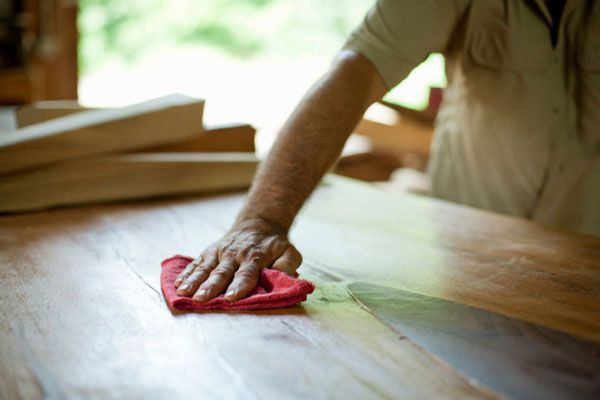
White Rings and Watermarks
White rings and watermarks are common issues that occur when moisture becomes trapped in the finish. These unsightly blemishes are often caused by placing wet glasses or hot dishes directly on wood surfaces without using coasters or trivets. Addressing them quickly can prevent them from setting deeper into the wood.
Surface Scratches and Dings
Even with careful use, wood furniture can develop surface scratches and dings over time. These minor imperfections can detract from the overall appearance of your pieces, but they are often easily remedied with the right techniques. Recognizing and treating them early can help maintain the integrity of your furniture.
Worn Edges and Faded Areas
Frequently used areas of wood furniture, such as table edges or armrests, can become worn or faded. This wear is normal but can make furniture look old and neglected if not addressed. Regular inspections and timely touch-ups can keep these areas looking fresh and well-maintained.
Essential Tools and Products for Wood Furniture Care
Having the right tools and products on hand is essential for effective wood furniture care. Here’s what you’ll need to keep your pieces in top condition.
Cleaning Supplies
For routine cleaning, gather these essentials:
- Soft, lint-free cloths
- Microfiber dusters
- Gentle wood cleaner (such as Murphy Oil Soap)
- Denatured alcohol for spot cleaning
Avoid ammonia-based cleaners, which can damage wood finishes. Proper cleaning supplies ensure that your furniture is cleaned without harming the finish.
Repair Materials
Keep these items on hand for quick repairs:
- Wax wood-filler sticks in various colors
- Felt-tip stain pens
- Shelled walnuts for minor scratch repair
- Fine-grit sandpaper
These repair materials allow you to address minor damages promptly, preventing them from becoming larger issues. Regular maintenance with these tools can significantly prolong the life of your wood furniture.
Protective Products
To maintain and protect your wood furniture, consider:
- Clear paste wax
- Furniture polish (silicone-free)
- Coasters and trivets
- Felt pads for furniture legs
Using these protective products helps preserve the wood’s finish and prevents future damage. Ensuring that your furniture is properly protected can save you from costly repairs down the line.
Step-By-Step Guide To Reviving Wood Furniture
Follow these expert techniques to bring your wood furniture back to life.
Cleaning and Dusting Techniques
Regular cleaning is key to maintaining wood furniture:
- Dust with a slightly damp cloth or microfiber duster.
- For deeper cleaning, use a gentle wood cleaner.
- Wipe in the direction of the wood grain.
- Dry thoroughly with a clean, soft cloth.
Avoid aerosol polishing sprays, as many contain silicone that can build up over time. Keeping your furniture clean prevents dust and dirt from creating micro scratches on the surface.
Buffing Out White Spots
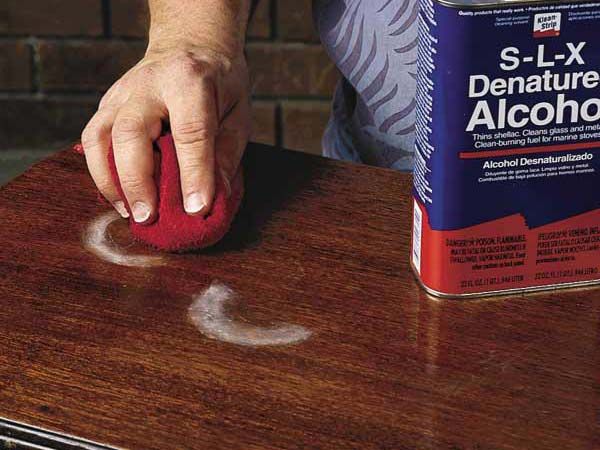
To remove white water marks:
- Lightly dampen a cloth with denatured alcohol.
- Gently wipe the affected area once to open up the finish.
- Allow the moisture to evaporate.
Michael Dresdner, author of The Woodfinishing Book, cautions, “Take care not to apply too much or you will remove the finish, leaving dull areas. ” It’s essential to utilize a gentle touch during this process to avoid further damage.
Repairing Surface Scratches
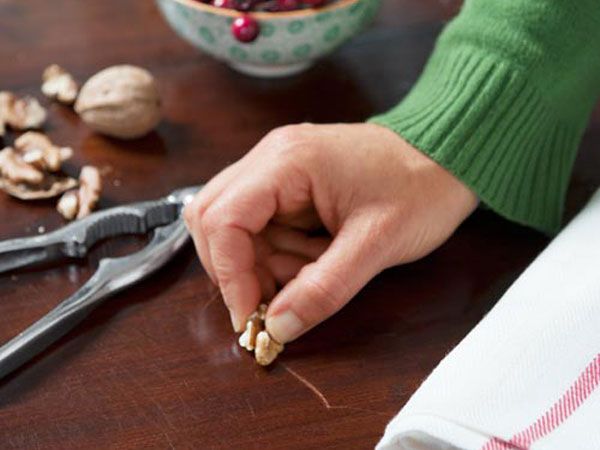
For minor scratches:
- Rub a shelled walnut gently across the mark.
- For deeper scratches, use a wax wood-filler stick matching the wood color.
- Overfill the scratch slightly.
- Smooth with a credit card.
- Wipe off excess with a clean, dry cloth.
This method allows you to blend scratches with the surrounding wood grain, making them less noticeable. Regularly inspecting your furniture for new scratches and addressing them quickly can keep your pieces looking their best.
Recoloring Worn Edges
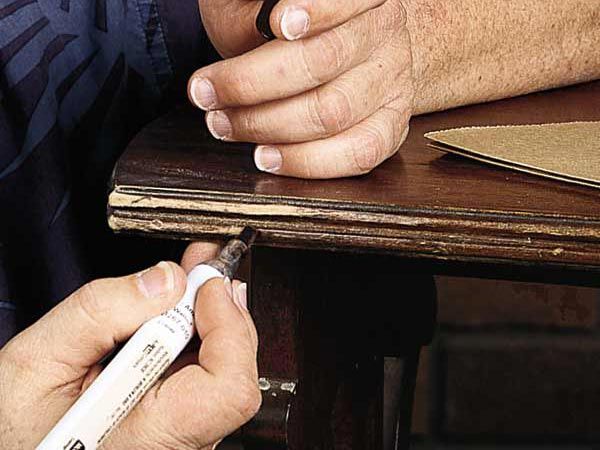
To address worn or faded areas:
- Use a felt-tip stain pen that matches the wood color.
- Carefully apply to worn edges, avoiding intact areas.
- Apply a coat of clear paste wax over the repair and surrounding area.
- Buff to an even sheen.
Recoloring worn edges helps maintain a uniform appearance, making your furniture look newer. Regular touch-ups on high-wear areas can prevent the wood from looking tired and aged.
Preventive Measures for Long-Lasting Wood Furniture
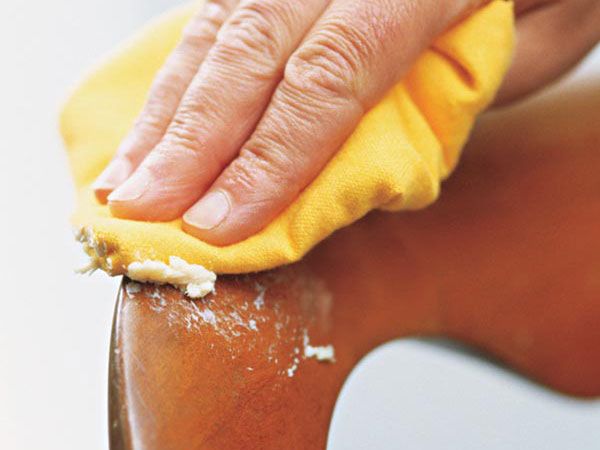
Taking preventive steps can significantly reduce the need for repairs and keep your wood furniture looking its best.
Controlling Humidity Levels
Wood expands and contracts with changes in humidity, which can lead to warping or cracking. Maintain a consistent humidity level in your home, ideally between 35% and 45%, to protect your furniture. Monitoring humidity levels can prevent substantial damage over time.
Using Coasters and Protective Pads
Always use coasters under glasses and trivets under hot dishes to prevent water marks and heat damage. Place protective pads under lamps, vases, and other items that remain on wood surfaces for extended periods. These simple measures can help preserve the wood’s finish.
Proper Placement in Your Home
Position wood furniture away from direct sunlight, heating vents, and air conditioning units. UV rays can fade wood finishes, while extreme temperature fluctuations can cause wood to expand and contract excessively. Proper placement within your home can prevent many common issues with wood furniture.
Professional Restoration vs. DIY Repairs for Wooden Furniture
While many wood furniture issues can be addressed at home, some situations call for professional help. Understanding when to involve experts is important for the long-term health of your pieces.
When To Call in the Experts
Consider professional restoration for:
- Antique or valuable pieces
- Extensive damage or deep scratches
- Refinishing projects
- Structural repairs
Professionals have the tools and expertise to handle complex restorations safely, ensuring the integrity and value of your furniture.
DIY-Friendly Restoration Projects
Many minor repairs and touch-ups are suitable for DIY:
- Cleaning and polishing
- Fixing small scratches and dings
- Addressing white watermarks
- Tightening loose joints
Always test repair techniques on an inconspicuous area first. Being equipped with the right knowledge and tools enables you to handle many routine issues independently.
Seasonal Care for Wood Furniture
Adapting your care routine to the changing seasons can help protect your wood furniture year-round.
Spring Cleaning Tips
During spring cleaning:
- Thoroughly dust and clean all wood surfaces.
- Inspect for any winter damage.
- Apply a fresh coat of wax or polish.
- Rearrange furniture to prevent uneven sun exposure.
Spring cleaning is a perfect time to reset your wood care routine and address any wear and tear accumulated over the winter.
Winter Protection Strategies
In winter:
- Use a humidifier to maintain proper moisture levels.
- Keep furniture away from heat sources.
- Clean more frequently to remove salt and grit tracked in from outside.
- Apply an extra layer of protection with quality furniture wax.
Winter conditions can be particularly harsh on wood furniture, making these steps essential to minimize damage.
Addressing Major Wood Furniture Repairs
While minor issues are often easily addressed, sometimes significant repairs become necessary. Understanding the process and when to seek professional help can save your valuable pieces.
Fixing Deep Scratches and Gouges
For deeper damage:
- Clean the area thoroughly to remove dirt and debris.
- Use a wood filler that matches the furniture color.
- Fill the scratch or gouge entirely and allow it to dry.
- Sand the area smooth with fine-grit sandpaper.
- Reapply wood stain or finish to match the surrounding area.
Replacing Damaged Veneer
If the veneer on your furniture is damaged:
- Carefully remove the damaged veneer with a utility knife.
- Measure and cut a replacement piece to fit the area.
- Apply wood glue to the piece and press it in place.
- Clamp the area securely and allow the glue to dry.
- Sand the edges smooth and finish to match the rest of the furniture.
Our Conclusion
Whether you’re dealing with a dinged dining room table or a ring-marked nightstand, understanding how to revive and protect your wood pieces is essential. Proper wood furniture care begins with understanding the basics.
